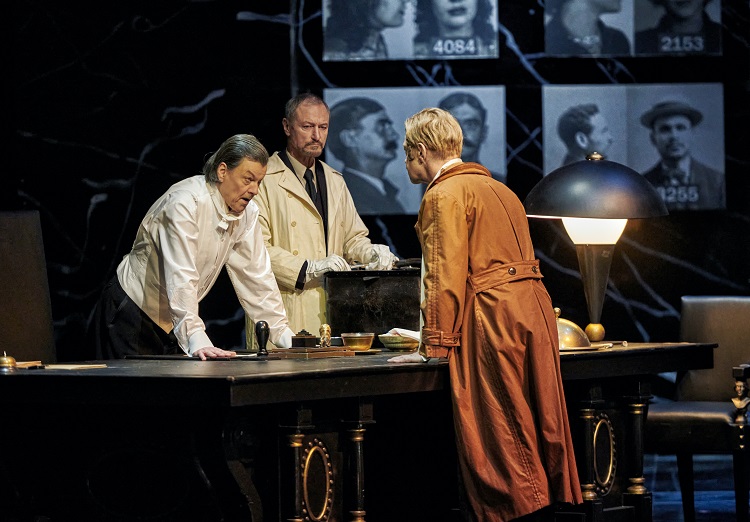 Sweden Puccini, Tosca: Soloists of Gothenburg Opera, Gothenburg Opera Chorus and Children’s chorus, Gothenburg Opera Orchestra / Ramón Tebar (conductor). Gothenburg Opera main stage, 17.10.2021. (NS)
Sweden Puccini, Tosca: Soloists of Gothenburg Opera, Gothenburg Opera Chorus and Children’s chorus, Gothenburg Opera Orchestra / Ramón Tebar (conductor). Gothenburg Opera main stage, 17.10.2021. (NS)

Production:
Original director – Lorenzo Mariani
Revival director – Mia Nerenius
Set design – Maurizio Baló
Costume design – Silvia Aymonino
Original lighting design – Christian Pinaud (revived by Karin Wijk)
Cast:
Floria Tosca – Carolina Sandgren
Mario Cavaradossi – Tomas Lind
Baron Scarpia – Mats Persson
Angelotti – Erik Rosenius
Sacristan – Anders Lorentzson
Spoletta – Daniel Ralphsson
Sciaronne – Jonas Landström
Jailer – Herbjörn Thordarson
Shepherd boy – Hannah Lyche
Lorenzo Mariani’s production of Tosca (sung in Italian) debuted in Gothenburg in 2009 but has already been a popular revival, thus it is a safe bet for the first post-COVID season at the Gothenburg Opera. Mariani’s Tosca is set in Fascist Italy in 1938, and the dark marble backdrops, deep shadows and pre-dawn gloom are a visual expression of the threat hanging over the characters. Set changes were skilfully used to dramatic effect, above all in the very final moments of the opera. The beginning of Act III, in contrast, was a brief pre-dawn idyll thanks to Hannah Lyche’s beautiful singing as the shepherd boy and the delicate lighting on the church towers of Rome. Another moment of beauty in the darkness was provided by the chorus singing the cantata with Tosca offstage in the second act.
The supporting cast included a delightful Sacristan (Anders Lorentzson) with his sensitive comic acting and all-too-believable cold sweats upon being questioned by the feared Baron Scarpia. But the most vivid characterisations came from Scarpia’s henchmen: Daniel Ralphsson’s Spoletta shrinking from the wrath of his boss while enjoying striking fear into others less fortunate; Jonas Landström’s Sciaronne emerging with grim satisfaction from the torture chamber, standing legs akimbo as if for a Fascist recruitment poster. But also Herbjörn Thordarson’s jailer, whose warm bass carried the undertone of decency and sympathy that provides what Cavaradossi thinks will be his last encouragement before his execution.
Sympathy (for the soloists) was however sometimes lacking from the pit. Parts of the first two acts were troubled by overly exuberant dynamics that threatened to drown out the soloists, generally in recitatives and duets. On the other hand, Ramón Tebar was adept at bringing forward the darker orchestral colours associated with Scarpia from the first meaty chords. And Act III turned out to be a small revelation: perfect balance and wonderful support for Tosca and Cavaradossi’s duet, as well as ravishingly beautiful orchestral playing.
Tomas Lind is by now an old hand as Cavaradossi and his acting felt very natural. Especially in the first act it felt like he was husbanding his voice for the key moments, such as a very good ‘Recondita armonia’ and lovely duet with the jealous Tosca. But with higher stakes in Act II came more fire in his confrontation with Scarpia and above all an exhilarating exclamation of ‘Vittoria!’ on his learning of Napoleon Bonaparte’s decisive victory at Marengo. In the final act he sang ‘E lucevan le stelle’ simply and expressively, full of regret for his last spoken words to the woman he loved and his reunion with Tosca immediately afterwards was supremely touching.

Mats Persson made a many-layered Scarpia, by turns terrifying, chilling and manipulative. Persson is a past master at acting with his voice, which was demonstrated in Act I with a velvet tone wrapped around an iron core. His manipulation of Tosca was smooth in the beginning but by Act II he skilfully moved between the superficial ‘good cop’ persona and exposing Scarpia’s depraved lust.
Carolina Sandgren was a gripping Tosca, effectively contrasting her theatrical but fundamentally decent and loving character with the darkness and unscrupulousness at Scarpia’s heart. She was believable and expressive in her first act duet with Cavaradossi and heartbreakingly vulnerable to Scarpia’s manipulation. Her acting was even better in Act II: ‘Vissi d’arte’ was a cry from the heart, performed simply, with no histrionics but only honest emotion. She was likewise tremendously moving in the Act III duet where she and Cavaradossi look forward to a life together in freedom. In both cases the effect on the audience was as heart-breaking as Puccini could have wished for.
Niklas Smith
